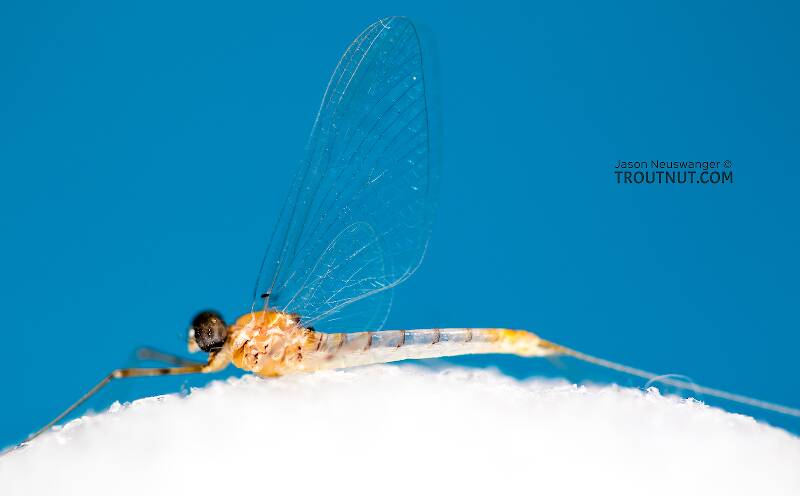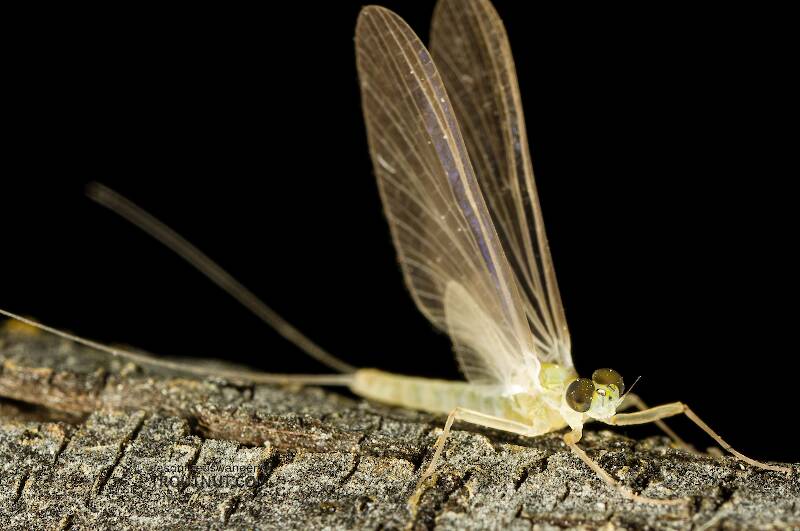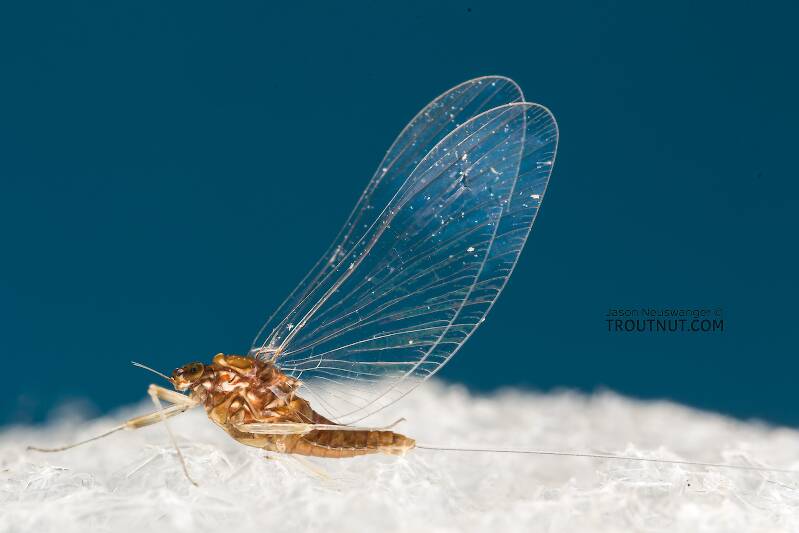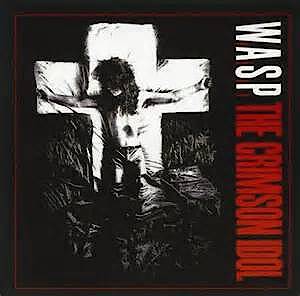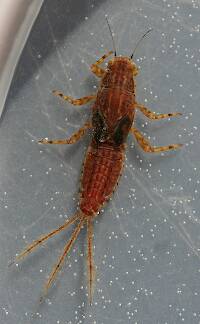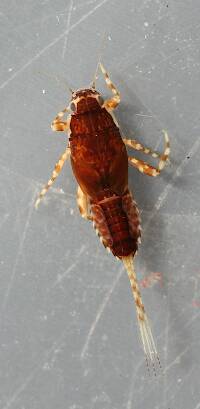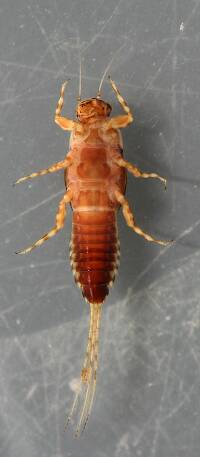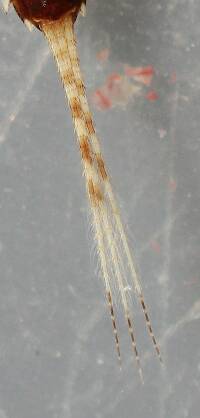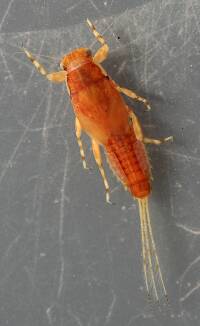
Salmonflies
Pteronarcys californica
The giant Salmonflies of the Western mountains are legendary for their proclivity to elicit consistent dry-fly action and ferocious strikes.
Featured on the forum

It's only barely visible in one of my pictures, but I confirmed under the microscope that this one has a prosternal horn and the antennae are mid-way between the eyes and front of the head capsule.
I'm calling this one Pycnopsyche, but it's a bit perplexing. It seems to key definitively to at least Couplet 8 of the Key to Genera of Limnephilidae Larvae. That narrows it down to three genera, and the case seems wrong for the other two. The case looks right for Pycnopsyche, and it fits one of the key characteristics: "Abdominal sternum II without chloride epithelium and abdominal segment IX with only single seta on each side of dorsal sclerite." However, the characteristic "metanotal sa1 sclerites not fused, although often contiguous" does not seem to fit well. Those sclerites sure look fused to me, although I can make out a thin groove in the touching halves in the anterior half under the microscope. Perhaps this is a regional variation.
The only species of Pycnopsyche documented in Washington state is Pycnopsyche guttifera, and the colors and markings around the head of this specimen seem to match very well a specimen of that species from Massachusetts on Bugguide. So I am placing it in that species for now.
Whatever species this is, I photographed another specimen of seemingly the same species from the same spot a couple months later.
I'm calling this one Pycnopsyche, but it's a bit perplexing. It seems to key definitively to at least Couplet 8 of the Key to Genera of Limnephilidae Larvae. That narrows it down to three genera, and the case seems wrong for the other two. The case looks right for Pycnopsyche, and it fits one of the key characteristics: "Abdominal sternum II without chloride epithelium and abdominal segment IX with only single seta on each side of dorsal sclerite." However, the characteristic "metanotal sa1 sclerites not fused, although often contiguous" does not seem to fit well. Those sclerites sure look fused to me, although I can make out a thin groove in the touching halves in the anterior half under the microscope. Perhaps this is a regional variation.
The only species of Pycnopsyche documented in Washington state is Pycnopsyche guttifera, and the colors and markings around the head of this specimen seem to match very well a specimen of that species from Massachusetts on Bugguide. So I am placing it in that species for now.
Whatever species this is, I photographed another specimen of seemingly the same species from the same spot a couple months later.

Troutnut is a project started in 2003 by salmonid ecologist Jason "Troutnut" Neuswanger to help anglers and
fly tyers unabashedly embrace the entomological side of the sport. Learn more about Troutnut or
support the project for an enhanced experience here.
This topic is about the Insect Order Ephemeroptera
Mayflies may be the most important insects for trout anglers to understand. They are an ancient order of insects, famous outside the fly-fishing world for their fragile beauty and short adult lifespan, often a single day to mate and die. The mayfly's poignant drama attracts poets and anglers alike, but anglers make the most of it.Mayflies live more than 99% of their lives as nymphs on the river or lake bottom, filling many crucial roles in freshwater ecosystems as they feed and grow. They eventually emerge from the water as winged sub-adults called "subimagos" by scientists and "duns" by anglers. Duns evolved to be good at escaping the water, with a hydrophobic surface and hardy build, but they are clumsy fliers. Within a day or two they molt one last time into "imagos" or "spinners," the mature adults, a transformation captured in this photo series of a dun molting into a spinner. They have longer legs and tails, and sleeker, more lightweight bodies, giving them the airborne speed, agility, and long grasp they need for their midair mating rituals. They are usually darker than the duns and have shinier, more transparent wings. They die within minutes or hours after mating.
Example specimens
GONZO on Jul 26, 2011July 26th, 2011, 7:34 pm EDT
but do you think that a Quill Gordon captured from a Catskill stream in 1890 would look much different than those of today?
No. I don't think Paul's comments about "evolution in motion" were intended to imply that the same species would look much different 100 years ago (or a thousand years ago). The differences between the flies of today and the flies of yesteryear have far more to do with the evolution of fly fishing than the evolution of mayflies.
Fly-fishing evolution is subject to rapid changes in popularity, fishing pressure, technology, the coming and going of fads and fashions, and is affected by the overall acceleration of change (including environmental change) that is associated with modern culture. When I began fly fishing, for example, fly tiers, fly-tying materials, and information about fly tying were about as scarce as hen's teeth when compared to the proliferation of all of those things today.
PaulRoberts on Jul 26, 2011July 26th, 2011, 9:08 pm EDT
I guess since it was brought it up, or there might be some confusion ... My lay understanding of it is: Yes, a fly-fisher would likely easily recognize Epeorus pleuralis, or say, Stenacron interpunctatum, of 1000 years ago. But would Jeff, or Luke recognize the same breadth of the Stenacron complex of that time; Would all the same derivations of the clade be present? Likely there would have been more of them.
Speciation by definition is the result of reproductive isolation –when creatures that might mate are inhibited from doing do. The quickest way to destroy radiation of a clade, besides pollution in its many forms, is to let ‘em mix and mate. There are a number of ways isolation can happen: geographic separation, ecological separation, random mutation –these all take various amounts of time, and the stepping stones are mutants, morphs, subspecies, … . A surviving schema with an environment that can support it, might differentiate enough over time to become a new species. The amount of time this might take depends in part on some of the other stuff I mentioned. Species "groups" or "complexes" tend to develop in such creatures that also have wide geographic distributions too, and the differences across that range may be recognized by one research tool or another. The tools don't create the differences, they allow us to measure them and ...speculate from whence they came, and possibly where they are going. The fact is, most lineages within a species die out.
So… there were likely interpunctatum 1000 years ago that Jeff and Luke had never seen before. Good riddance some FFs might say, lol. But a good “Light Cahill” would cover them all just fine with a few structural variations mebbe. Which begs the question I’m sure many reading “the bug boys” wonder: How much of this matters to anglers?
Certainly not all of it. But in fishing the devil is truly in the details, and ecological and behavioral understanding is really the holy grail in fishing, esp FF (and the stuff we’ve all managed to avoid talking about in this thread lol.) Read GONZO’s discussion/disclosures on E. cornuta/lata a short time ago; That’s knowledge we can take right to the stream.
But identification is the start. My wife hates it when I identify stuff (albeit I do it ALL the time). But I have to argue that, once you know what you are looking at, you can start to recognize the differences, bringing some depth perspective, and therein lies the devil. You then have the opportunity to recognize ecological and behavioral elements beneath –the things an angler can really take advantage of.
Nothing compares to the satisfaction of duping a good fish, or a bunch of them, like you meant to do it. Knowing, and then seeing it unfold in front of you, is powerful medicine. Anyone who studies nature, from scientists to naturalists to anglers, follows the same general path, from the observational to the predictive.
Now, in an attempt to bring this thread back into the practical (nonscientific) realm, I began to address the ecological and behavioral elements I’ve seen for subvaria/invaria/dorothea, but realize much of it is buried away in the archives of my fishing journals now. Use it or lose it, as they say. :( I’ll try to dig something up and maybe others will pipe in. Maybe it’s a different thread?
Speciation by definition is the result of reproductive isolation –when creatures that might mate are inhibited from doing do. The quickest way to destroy radiation of a clade, besides pollution in its many forms, is to let ‘em mix and mate. There are a number of ways isolation can happen: geographic separation, ecological separation, random mutation –these all take various amounts of time, and the stepping stones are mutants, morphs, subspecies, … . A surviving schema with an environment that can support it, might differentiate enough over time to become a new species. The amount of time this might take depends in part on some of the other stuff I mentioned. Species "groups" or "complexes" tend to develop in such creatures that also have wide geographic distributions too, and the differences across that range may be recognized by one research tool or another. The tools don't create the differences, they allow us to measure them and ...speculate from whence they came, and possibly where they are going. The fact is, most lineages within a species die out.
So… there were likely interpunctatum 1000 years ago that Jeff and Luke had never seen before. Good riddance some FFs might say, lol. But a good “Light Cahill” would cover them all just fine with a few structural variations mebbe. Which begs the question I’m sure many reading “the bug boys” wonder: How much of this matters to anglers?
Certainly not all of it. But in fishing the devil is truly in the details, and ecological and behavioral understanding is really the holy grail in fishing, esp FF (and the stuff we’ve all managed to avoid talking about in this thread lol.) Read GONZO’s discussion/disclosures on E. cornuta/lata a short time ago; That’s knowledge we can take right to the stream.
But identification is the start. My wife hates it when I identify stuff (albeit I do it ALL the time). But I have to argue that, once you know what you are looking at, you can start to recognize the differences, bringing some depth perspective, and therein lies the devil. You then have the opportunity to recognize ecological and behavioral elements beneath –the things an angler can really take advantage of.
Nothing compares to the satisfaction of duping a good fish, or a bunch of them, like you meant to do it. Knowing, and then seeing it unfold in front of you, is powerful medicine. Anyone who studies nature, from scientists to naturalists to anglers, follows the same general path, from the observational to the predictive.
Now, in an attempt to bring this thread back into the practical (nonscientific) realm, I began to address the ecological and behavioral elements I’ve seen for subvaria/invaria/dorothea, but realize much of it is buried away in the archives of my fishing journals now. Use it or lose it, as they say. :( I’ll try to dig something up and maybe others will pipe in. Maybe it’s a different thread?
Adirman on Jul 27, 2011July 27th, 2011, 2:22 am EDT
Gonzo;
Oh. I was under the impression he was talking about Mayfly evolution occurring a little more rapidly then say, mammals cuz of their wide distribution and reproductive rate and thus, explains changes in flies/flyfishing, etc. Still though, it would be cool to check out the variations of a species in a single location say, the Catskills in 1000 yrs to see how the average individuals compare then and now.
Oh. I was under the impression he was talking about Mayfly evolution occurring a little more rapidly then say, mammals cuz of their wide distribution and reproductive rate and thus, explains changes in flies/flyfishing, etc. Still though, it would be cool to check out the variations of a species in a single location say, the Catskills in 1000 yrs to see how the average individuals compare then and now.
Shawnny3 on Jul 27, 2011July 27th, 2011, 5:40 am EDT
I believe he did mean that the evolution of insects happens faster than that of mammals, but it's still a slow process in comparison with the timescale of modern flyfishing.
-Shawn
-Shawn
Jewelry-Quality Artistic Salmon Flies, by Shawn Davis
www.davisflydesigns.com
www.davisflydesigns.com
Oldredbarn on Jul 27, 2011July 27th, 2011, 6:02 am EDT
I think what may be important here, something we haven't really mentioned it seems, is not neccesarily the evolution of the bug, or our sport, but the changes that have occurred in scientific technology and the tools now available to entomologists for observing the critters...They are talking DNA now! Improved optics and equipment & photography...Jeff & Luke and their colleagues have tools that their predessors could only dream of...They may be looking at a bug that appears to be the same but maybe they are seeing things we really couldn't see in the past.
How would things have been different if old Christopher Co-lum-bo had GPS?! Or could bounce navigational signals off satelites...His view of the world probably would of been different and he may have actually arrived at the place he had set off to find.
As an angler I may not find all this "stuff" useful...I'm not caring a microscope out on the stream, but as a curious old son-of-a-gun I sure find it interesting.
Getting from point A to point B is never easy but we are inching a little further down the road all the time. When I drove truck during my university days at the Detroit Free Press we use to have a saying...When I first started out I didn't have a bid run that I pulled all the time but would cover for guys that called in sick etc...I would look at the manifest and would ask around for help finding my way to the stops on it and the old timers would grin and say, "Spence...You'll know it when you get back." ;)
Fellas! I think that's just about as optimistic as you'll ever see Spence so enjoy it while it lasts...I'm heading over for my second cup of tea and see if I can re-establish my growl...I feel rather odd. :)
How would things have been different if old Christopher Co-lum-bo had GPS?! Or could bounce navigational signals off satelites...His view of the world probably would of been different and he may have actually arrived at the place he had set off to find.
As an angler I may not find all this "stuff" useful...I'm not caring a microscope out on the stream, but as a curious old son-of-a-gun I sure find it interesting.
Getting from point A to point B is never easy but we are inching a little further down the road all the time. When I drove truck during my university days at the Detroit Free Press we use to have a saying...When I first started out I didn't have a bid run that I pulled all the time but would cover for guys that called in sick etc...I would look at the manifest and would ask around for help finding my way to the stops on it and the old timers would grin and say, "Spence...You'll know it when you get back." ;)
Fellas! I think that's just about as optimistic as you'll ever see Spence so enjoy it while it lasts...I'm heading over for my second cup of tea and see if I can re-establish my growl...I feel rather odd. :)
"Even when my best efforts fail it's a satisfying challenge, and that, after all, is the essence of fly fishing." -Chauncy Lively
"Envy not the man who lives beside the river, but the man the river flows through." Joseph T Heywood
"Envy not the man who lives beside the river, but the man the river flows through." Joseph T Heywood
PaulRoberts on Jul 27, 2011July 27th, 2011, 8:02 am EDT
Fellas! I think that's just about as optimistic as you'll ever see Spence so enjoy it while it lasts...I'm heading over for my second cup of tea and see if I can re-establish my growl...I fell rather odd. :)
Well, good morning sunshine!!!
Gonzo;
Oh. I was under the impression he was talking about Mayfly evolution occurring a little more rapidly then say, mammals cuz of their wide distribution and reproductive rate and thus, explains changes in flies/flyfishing, etc. Still though, it would be cool to check out the variations of a species in a single location say, the Catskills in 1000 yrs to see how the average individuals compare then and now.
One theory called "punctuated equilibrium" suggests that species can remain stable for long periods (think Coelocanth, Lamprey, Opossum, and some stoneflies) until some event accelerates change in a population, adding a new stem to the clade. It can happen to anyone (population), but insects may be more plastic so to speak bc of their small size, often diverse habitats, and short generational span. The bush can also be pruned of course, and this is a worry for those biodiversity wacko's (count me in) who have the knowledge and tools to recognize them, and that all their work allows them to watch disappear. (There's the nice dark cloud for you to sip your tea by, Spence. I have this mostly unfounded belief that "beauty" is the recognition of the promise that intricacy and diversity holds. It didn't begin with Van Gogh, or Homer, or...cave painting. Every snail knows beauty.)
What's important in the fishing and fly-tying is both old--taking advantage of the ecological realm and behaviors of different trout food, and the trout's own behaviors and abilities to find and identify that "food"--and MUCH more recent in terms of trout's reactions to a very new predator on the block -the modern hook and line angler. Fish DO learn, and surprisingly fast. Here in Colorado I can fish to trout of VERY different levels of education, on the same stream. In the remote areas of the high elevations (where almost no one goes) there are trout that will rise or take repeatedly to a generic "bug receptor tripper" fly pattern, to the point of being pricked more than once! Unheard of several miles below closer to the roads where you can find trout that will scrutinize a fly and reject it for maddening reasons. The two games are VERY different.
GONZO on Jul 27, 2011July 27th, 2011, 8:08 am EDT
Still though, it would be cool to check out the variations of a species in a single location say, the Catskills in 1000 yrs to see how the average individuals compare then and now.
It would be very interesting to be able to make a first-hand comparison of many of our favorite trout streams to those same waters 100 or 1000 years ago, but I suspect that noticeable differences in the appearance of individual mayfly species would be among the least apparent differences. The streams might look very different; the anglers and their methods would be different; in many cases, the fish species would be different; the diversity or population levels of various mayflies might also be very different, but the species probably wouldn't look much different.
That's not to say that the same changes that made the other things look very different 100 or 1000 years ago have not had some effect on mayfly evolution. Manmade environmental changes can lead to significant population changes in a very short time, and we are probably reducing diversity in ways that might lead to population bottlenecks all the time. Very rapid changes in the appearance of mayflies are also possible through selective breeding. Fortunately, we have refrained from that (so far as I know). Imagine what might happen to our favorite mayflies if we bred them like domestic animals or food crops!
I don't look forward to that time. So much has changed, even in my lifetime, that I find some comfort in the thought that the Quill Gordon that I see on a Catskill stream probably looks much the same as it would have looked to Theodore Gordon or even to the Mohicans or Munsees.
Fish DO learn, and surprisingly fast. Here in Colorado I can fish to trout of VERY different levels of education, on the same stream. In the remote areas of the high elevations (where almost no one goes) there are trout that will rise or take repeatedly to a generic "bug receptor tripper" fly pattern, to the point of being pricked more than once! Unheard of several miles below closer to the roads where you can find trout that will scrutinize a fly and reject it for maddening reasons. The two games are VERY different.
Agreed, Paul, and fly fishers that fish more or less exclusively in one situation or another will make different tactical choices, fly design/selection being just one.
Shawnny3 on Jul 27, 2011July 27th, 2011, 10:41 am EDT
Fish DO learn, and surprisingly fast. Here in Colorado I can fish to trout of VERY different levels of education, on the same stream. In the remote areas of the high elevations (where almost no one goes) there are trout that will rise or take repeatedly to a generic "bug receptor tripper" fly pattern, to the point of being pricked more than once! Unheard of several miles below closer to the roads where you can find trout that will scrutinize a fly and reject it for maddening reasons. The two games are VERY different.
While I'm sure Paul understands this distinction, let me point out to those that might not that this type of learning does not constitute evolution, at least not in the genetic sense, being that the knowledge dies with the individual without being passed down. That a fish is teachable, though, may give its species an edge over less acute-learning species over time. The dodo's trusting and inquisitive demeanor, for example, is what led to its rapid demise. The brook trout may suffer some in that regard, as well, compared with other trout.
-Shawn
Jewelry-Quality Artistic Salmon Flies, by Shawn Davis
www.davisflydesigns.com
www.davisflydesigns.com
PaulRoberts on Jul 27, 2011July 27th, 2011, 11:36 am EDT
Yes, populations can "evolve", not individuals. While individuals can learn, and even pass it along by word and example, this knowledge does not end up in the genes. Knowledge may offer certain selective advantages that allow a certain gene pool to get passed along, and then again it might not.
If, say, the repositories of learning that science and FF have contributed to our body of knowledge up til now on aquatic insects was lost to some enormous catastrophe, then all that knowledge would be gone -POOF! And it wouldn't just reappear in the head of some descendant born later. There would be no genetic record. POOF! Gone.
If, say, the repositories of learning that science and FF have contributed to our body of knowledge up til now on aquatic insects was lost to some enormous catastrophe, then all that knowledge would be gone -POOF! And it wouldn't just reappear in the head of some descendant born later. There would be no genetic record. POOF! Gone.
Entoman on Jul 27, 2011July 27th, 2011, 11:42 am EDT
Hi everbody,
Wow... "Gone fishing" for a few days and I miss this great thread! This is one that should have a star next to it in the archives, Jason. Too many great comments to quote, but I do have a few observations from a fishing standpoint that might be worth consideration in this discussion.
Regarding the ephemerillid subimagos, in terms of habitat, behavior and especially appearance, I have observed greater similarities between infrequens and invaria than either with dorothea. In fact, I haven't observed (with the possible exception of a little yellow guy on the Dechutes) a western infrequens that is not pretty easy to tell from it's eastern counterpart, and not just color but the way they are "built". On the other hand, I've observed hatches of both invaria and infrequens that would be impossible to tell apart in the hand and the angler would be stumped if it weren't for the differences in region. Because this comment is based on live observance, until the proliferation of live specimen photographs became available I considered this merely anecdotal. I'm not so sure any more.
Regarding the baetid subimagos, I must admit a little (lot) confusion over discounting large taxonomic differences in placing species. Ironically, the larger fuss among anglers over the heptageniid subimagos vicarium and fuscum pales in comparison to my way of thinking. Commonsense dictates that lacking body parts trumps variations in size and color in an otherwise identical insect. It's understood that determining "divergence" is largely dependant on the baseline used and I'm curious how this will play out. It's also true I guess that there are anomalies that need further investigation.
One problem we anglers seldom mention when discussing differences is the added difficulty of throwing larvae into mix. What anatomical differences (or similarities) are more significant? The wonder and fun of the search for knowledge is that it seems with every question answered, ten new ones take it's place:)
Regards,
Kurt
Wow... "Gone fishing" for a few days and I miss this great thread! This is one that should have a star next to it in the archives, Jason. Too many great comments to quote, but I do have a few observations from a fishing standpoint that might be worth consideration in this discussion.
Regarding the ephemerillid subimagos, in terms of habitat, behavior and especially appearance, I have observed greater similarities between infrequens and invaria than either with dorothea. In fact, I haven't observed (with the possible exception of a little yellow guy on the Dechutes) a western infrequens that is not pretty easy to tell from it's eastern counterpart, and not just color but the way they are "built". On the other hand, I've observed hatches of both invaria and infrequens that would be impossible to tell apart in the hand and the angler would be stumped if it weren't for the differences in region. Because this comment is based on live observance, until the proliferation of live specimen photographs became available I considered this merely anecdotal. I'm not so sure any more.
Regarding the baetid subimagos, I must admit a little (lot) confusion over discounting large taxonomic differences in placing species. Ironically, the larger fuss among anglers over the heptageniid subimagos vicarium and fuscum pales in comparison to my way of thinking. Commonsense dictates that lacking body parts trumps variations in size and color in an otherwise identical insect. It's understood that determining "divergence" is largely dependant on the baseline used and I'm curious how this will play out. It's also true I guess that there are anomalies that need further investigation.
One problem we anglers seldom mention when discussing differences is the added difficulty of throwing larvae into mix. What anatomical differences (or similarities) are more significant? The wonder and fun of the search for knowledge is that it seems with every question answered, ten new ones take it's place:)
Regards,
Kurt
"It's not that I find fishing so important, it's just that I find all other endeavors of Man equally unimportant... And not nearly as much fun!" Robert Traver, Anatomy of a Fisherman
PaulRoberts on Jul 27, 2011July 27th, 2011, 11:57 am EDT
... The wonder and fun of the search for knowledge is that it seems with every question answered, ten new ones take it's place:)
Regards,
Kurt
Congratulations! You have reached Nirvana! Yes, that's all there is. Sorry. :)
(Spence, have we depressed you enough yet? No, your fly boxes will NEVER be "complete". Isaac Walton was only fooling himself when he wrote that title. But we can cut him the slack; He didn't own a good dissecting scope nor have access to molecular analysis.)
Maybe here's the sunny side: How much "beauty" can we stand??
GONZO on Jul 27, 2011July 27th, 2011, 12:22 pm EDT
While I'm sure Paul understands this distinction,let me point out to those that might not that this type of learning does not constitute evolution, at least not in the genetic sense, being that the knowledge dies with the individual without being passed down. That a fish is teachable, though, may give its species an edge over less acute-learning species over time. The dodo's trusting and inquisitive demeanor, for example, is what led to its rapid demise. The brook trout may suffer some in that regard, as well, compared with other trout.
Good point, Shawn.
In the case of the brook trout, some of their reputation for gullibilty may have as much to do with the situations in which we most often encounter them as it does with any inherent "dumbness" or lack thereof. In small freestone tribs and headwaters, they can often maintain higher numbers than some other species of "trout." The competitive pressure that is created compels a degree of rashness that I don't usually see when (smaller numbers) of browns occupy similar situations. I'm not saying that there aren't many important differences between brookies and browns, but their relative intelligence (as a species) can be misinterpreted at times.
In other, less common situations, brook trout can seem about as spooky and fussy as browns. The former and current wild strains occupying PA's Big Spring are a good example. Marinaro and Schwiebert both wrote about the character of the former strain, with Schwiebert (in his original Nymphs) saying this:
Its wild brook trout are a selective, free-rising strain that mock the conventional fly fishing wisdom about Salvelinus fontanalis--that our native eastern fish are indifferent surface feeders with limited intelligence....Their rises dimple and porpoise and sip in the surface, but floating flies from jassids and ants to no-hackle midges are refused so completely they are not even honored with curious inspection rises....
What makes me think that this is more a function of the situation than any inherent difference, even between various strains of brook trout, is that I strongly suspect that the current Big Spring wild strain has only a distant connection to the former one, though it behaves in much the same way. Most of the wild brook trout currently occupying Big Spring may directly descend from a Canadian strain, rather than from the former PA residents. (As I understand it, Ernie played a role in that as well.) However, because the food that caused the former strain to rise so freely is somewhat different than at the time Schwiebert describes, many anglers refuse to believe that Big Spring holds as many post-recovery wild brook trout as it actually does.
Oldredbarn on Jul 27, 2011July 27th, 2011, 12:24 pm EDT
You guys are just too much fun for me to be really depressed Paul...;) Besides, I think they finally got the balance on my meds right...Just kidding.
Damn Paul!...And here I was hoping I'd eventually be able to get by with just the infamous "12" the princess gave us...Maybe she was just a dame...I can't remember.
Now I know that this is just anedotal, but I have never had any problems, on my trips out west, using my Michigan "Light Henny" patterns to cover PMD's...I know I shouldn't admit this, it's cheating, sort of, but hey! I had a lot of other flies to tie!
Is this correct gentlemen?
Spence
your fly boxed will NEVER be "complete". Isaac Walton was only fooling himself when he wrote that title
Damn Paul!...And here I was hoping I'd eventually be able to get by with just the infamous "12" the princess gave us...Maybe she was just a dame...I can't remember.
Now I know that this is just anedotal, but I have never had any problems, on my trips out west, using my Michigan "Light Henny" patterns to cover PMD's...I know I shouldn't admit this, it's cheating, sort of, but hey! I had a lot of other flies to tie!
Entomologists used to split this species into E. inermis and E. infrequens, E. inermis being smaller but much more numerous. However, both have now been lumped into E. excrucians
Spence
"Even when my best efforts fail it's a satisfying challenge, and that, after all, is the essence of fly fishing." -Chauncy Lively
"Envy not the man who lives beside the river, but the man the river flows through." Joseph T Heywood
"Envy not the man who lives beside the river, but the man the river flows through." Joseph T Heywood
GONZO on Jul 27, 2011July 27th, 2011, 12:29 pm EDT
No. Who said that?
Oldredbarn on Jul 27, 2011July 27th, 2011, 12:34 pm EDT
(There's the nice dark cloud for you to sip your tea by, Spence. I have this mostly unfounded belief that "beauty" is the recognition of the promise that intricacy and diversity holds. It didn't begin with Van Gogh, or Homer, or...cave painting. Every snail knows beauty.)
Paul...Paul...Maybe in a PM I'll give you a moment or two to explain this, but otherwise just step back from the pipe ;)...This medical marijuana things has gotten out-of-hand!
Just kidding...I couldn't help myself here.
Spence
No. Who said that?
I have to run! Meeting a client in a half-an-hour...
"Even when my best efforts fail it's a satisfying challenge, and that, after all, is the essence of fly fishing." -Chauncy Lively
"Envy not the man who lives beside the river, but the man the river flows through." Joseph T Heywood
"Envy not the man who lives beside the river, but the man the river flows through." Joseph T Heywood
GONZO on Jul 27, 2011July 27th, 2011, 1:34 pm EDT
Yes, Spence, both were (and still are) often called PMDs. However that website has the details of the reclassification mixed up.
Taxon on Jul 27, 2011July 27th, 2011, 2:46 pm EDT
Yes, Spence, both were (and still are) often called PMDs. However that website has the details of the reclassification mixed up.
Hi Lloyd-
I don't see any taxonomy on the linked page other than a reference to genus Ephemerella. Just out of curiosity, where (exactly) on westfly are "details of the reclassification" mixed up?
Entoman on Jul 27, 2011July 27th, 2011, 2:47 pm EDT
Spence -
Regardless of who said this, they are confused. There is no species that was "split" (whatever that means) between infrequens and inermis and of the two, only inermis has been combined with excrucians. The also important infrequens has retained it's name but is now considered a subspecies with dorothea. Hence the handles dorothea dorothea and dorothea infrequens have now lovingly and without rancor joyously entered the anglers lexicon.:) You are right though that they all have been erroneously lumped under PMD. Kinda the West's version of BWO?
Kurt
Entomologists used to split this species into E. inermis and E. infrequens, E. inermis being smaller but much more numerous. However, both have now been lumped into E. excrucians
Regardless of who said this, they are confused. There is no species that was "split" (whatever that means) between infrequens and inermis and of the two, only inermis has been combined with excrucians. The also important infrequens has retained it's name but is now considered a subspecies with dorothea. Hence the handles dorothea dorothea and dorothea infrequens have now lovingly and without rancor joyously entered the anglers lexicon.:) You are right though that they all have been erroneously lumped under PMD. Kinda the West's version of BWO?
Kurt
"It's not that I find fishing so important, it's just that I find all other endeavors of Man equally unimportant... And not nearly as much fun!" Robert Traver, Anatomy of a Fisherman
GONZO on Jul 27, 2011July 27th, 2011, 4:17 pm EDT
I don't see any taxonomy on the linked page other than a reference to genus Ephemerella. Just out of curiosity, where (exactly) on westfly are "details of the reclassification" mixed up?
Hi Roger,
The next to last paragraph in the section "About Pale Morning Duns" on the linked page is exactly what Spence quoted above.
Taxon on Jul 27, 2011July 27th, 2011, 4:38 pm EDT
Thanks Lloyd, I see it now.
Quick Reply
Related Discussions
Topic
Replies
Last Reply
0
Jun 29, 2020
by Wiflyfisher
by Wiflyfisher
Re: So is Ep Infrequens now known as Ep Dorothea?
In the Mayfly Species Ephemerella dorothea infrequens by Wbranch
In the Mayfly Species Ephemerella dorothea infrequens by Wbranch
20
Jul 1, 2014
by Crepuscular
by Crepuscular
7
Sep 18, 2006
by Troutnut
by Troutnut
25
Jan 8, 2016
by Wbranch
by Wbranch


